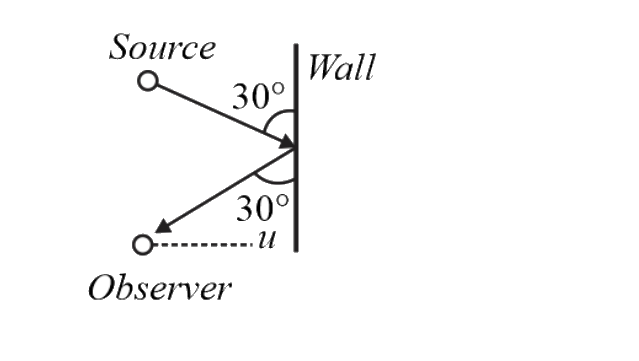A sound source emits waves of frequency f0 and wavelength λ0 in still air. When there is a wind blowing with speed u from left to right what will be wavelength of sound to the right of the source and to the left of the source.
The correct Answer is:λ0+uf0,λ0−uf0
Step by step video, text & image solution for A sound source emits waves of frequency f_(0) and wavelength lambda_(0) in still air. When there is a wind blowing with speed u from left to right what will be wavelength of sound to the right of the source and to the left of the source. by Physics experts to help you in doubts & scoring excellent marks in Class 11 exams.
Updated on:21/07/2023Topper's Solved these Questions
Similar Questions
A stationary source emits sound of frequency
υ=1200Hz. If a wind blows at the speed of 0.1c deduce (i) the percentage change in the wavelength and (ii) the change in the frequency for a stationary observer on the wind side of the source. What happens when there is no wind, but the observer moves at speed 0.1c towards the source?
View SolutionA stationary source (see figure) emits sound waves of frequency f towards a stationary wall. If an observer moving with speed u in a direction perpendicular to the wall measures a frequency f'=118f at the instant shown, then u is related to the speed of sound Vs as

View Solution
Knowledge Check
A sound source emits sound waves of frequency 500 Hz and wavelength 0.2 m. How long does it take the waves to travel 300 m.
A75 sB60 sC12 sD3 sA sound source sends waves of 600 Hz. It produces a wavelength of 3 m. The velocity of the sound wave in question is :
A1800ms−1B1800ms−2C1800ms2D1800ms1A sound source emits sound waves of 400 Hz. It produces waves of wavelength 2.5 m. The velocity of sound waves is
A100 m/sB1000 m/sC10000 m/sD3000 km/s
A sound source A and a reflecting surface B move directly toward each other. Relative to the air, the speed of source A is 20.0 m/s, the speed of surface B is 80.0 m/s, and the speed of sound is 329 m/s. The source emits waves at frequency 2000 Hz as measured in the source frame. In the reflector frame, what are the (a) frequency and (b) wavelength of the arriving sound waves? In the source frame, what are the (c) frequency and (d) wavelength of the sound waves reflected back to the source?
View Solution(i) A source of sound emits waves of frequency f0=1200Hz. The source is travelling at a speed of v1=30m/s towards east. There is a large reflecting surface in front of the source which is travelling at a velocity of v2=60m/s towards west. Speed of sound in air is v=330m/s.
(a) Find the number of waves arriving per second at the reflecting surface.
(b) Find the ratio of wavelength (λ1) of sound in front of the source travelling towards the reflecting surface to the wavelength (λ2) of sound in front of the source approaching it after getting reflected.
(ii) A sound source (S) and an observer (A) are moving towards a point O along two straight lines making an angle of 60∘ with each other. The velocities of S and A are 18ms–1 and 12ms–1 respectively and remain constant with time. Frequency of the source is 1000Hz and speed of sound is v=330ms–1.
(a) Find the frequency received by the observer when both the source and observer are at a distance of 180 m from point O (see figure). (b) Find the frequency received by the observer when she reaches point O.
View SolutionA source of sound S having frequency f. Wind is blowing from source to observer O with velocity u. If speed of sound with respect to air is C, the wavelength of sound detected by O is :
View SolutionA source of sound produces waves of wavelength 60 cm when it is stationary if the speed of sound in air is 320ms and source moves with speed 20ms, the wavelength of sound in the forward direction will be nearest to
View SolutionA source of sound produces waves of wave length 48cm. This source is moving towards north with speed V/4 where V is speed of sound. The apparent wavelength of the waves to an observer standing south of the moving source will be
View Solution
